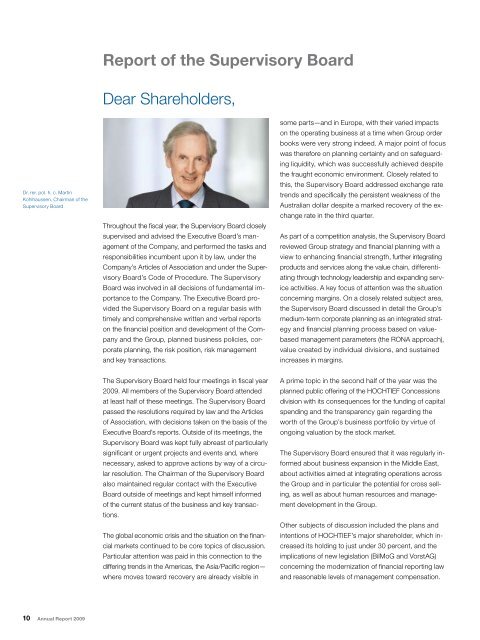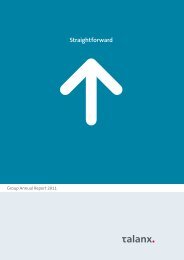ONE ROOF
ONE ROOF
ONE ROOF
You also want an ePaper? Increase the reach of your titles
YUMPU automatically turns print PDFs into web optimized ePapers that Google loves.
Dr. rer. pol. h. c. Martin<br />
Kohlhaussen, Chairman of the<br />
Supervisory Board<br />
10 Annual Report 2009<br />
Report of the Supervisory Board<br />
Dear Shareholders,<br />
Throughout the fiscal year, the Supervisory Board closely<br />
supervised and advised the Executive Board’s management<br />
of the Company, and performed the tasks and<br />
responsibilities incumbent upon it by law, under the<br />
Company’s Articles of Association and under the Supervisory<br />
Board’s Code of Procedure. The Supervisory<br />
Board was involved in all decisions of fundamental importance<br />
to the Company. The Executive Board provided<br />
the Supervisory Board on a regular basis with<br />
timely and comprehensive written and verbal reports<br />
on the financial position and development of the Company<br />
and the Group, planned business policies, corporate<br />
planning, the risk position, risk management<br />
and key transactions.<br />
The Supervisory Board held four meetings in fiscal year<br />
2009. All members of the Supervisory Board attended<br />
at least half of these meetings. The Supervisory Board<br />
passed the resolutions required by law and the Articles<br />
of Association, with decisions taken on the basis of the<br />
Executive Board’s reports. Outside of its meetings, the<br />
Supervisory Board was kept fully abreast of particularly<br />
significant or urgent projects and events and, where<br />
necessary, asked to approve actions by way of a circular<br />
resolution. The Chairman of the Supervisory Board<br />
also maintained regular contact with the Executive<br />
Board outside of meetings and kept himself informed<br />
of the current status of the business and key transactions.<br />
The global economic crisis and the situation on the finan-<br />
cial markets continued to be core topics of discussion.<br />
Particular attention was paid in this connection to the<br />
differing trends in the Americas, the Asia/Pacific region—<br />
where moves toward recovery are already visible in<br />
some parts—and in Europe, with their varied impacts<br />
on the operating business at a time when Group order<br />
books were very strong indeed. A major point of focus<br />
was therefore on planning certainty and on safeguarding<br />
liquidity, which was successfully achieved despite<br />
the fraught economic environment. Closely related to<br />
this, the Supervisory Board addressed exchange rate<br />
trends and specifically the persistent weakness of the<br />
Australian dollar despite a marked recovery of the exchange<br />
rate in the third quarter.<br />
As part of a competition analysis, the Supervisory Board<br />
reviewed Group strategy and financial planning with a<br />
view to enhancing financial strength, further integrating<br />
products and services along the value chain, differentiating<br />
through technology leadership and expanding service<br />
activities. A key focus of attention was the situation<br />
concerning margins. On a closely related subject area,<br />
the Supervisory Board discussed in detail the Group’s<br />
medium-term corporate planning as an integrated strategy<br />
and financial planning process based on valuebased<br />
management parameters (the RONA approach),<br />
value created by individual divisions, and sustained<br />
increases in margins.<br />
A prime topic in the second half of the year was the<br />
planned public offering of the HOCHTIEF Concessions<br />
division with its consequences for the funding of capital<br />
spending and the transparency gain regarding the<br />
worth of the Group’s business portfolio by virtue of<br />
ongoing valuation by the stock market.<br />
The Supervisory Board ensured that it was regularly in-<br />
formed about business expansion in the Middle East,<br />
about activities aimed at integrating operations across<br />
the Group and in particular the potential for cross selling,<br />
as well as about human resources and management<br />
development in the Group.<br />
Other subjects of discussion included the plans and<br />
intentions of HOCHTIEF’s major shareholder, which increased<br />
its holding to just under 30 percent, and the<br />
implications of new legislation (BilMoG and VorstAG)<br />
concerning the modernization of financial reporting law<br />
and reasonable levels of management compensation.
















